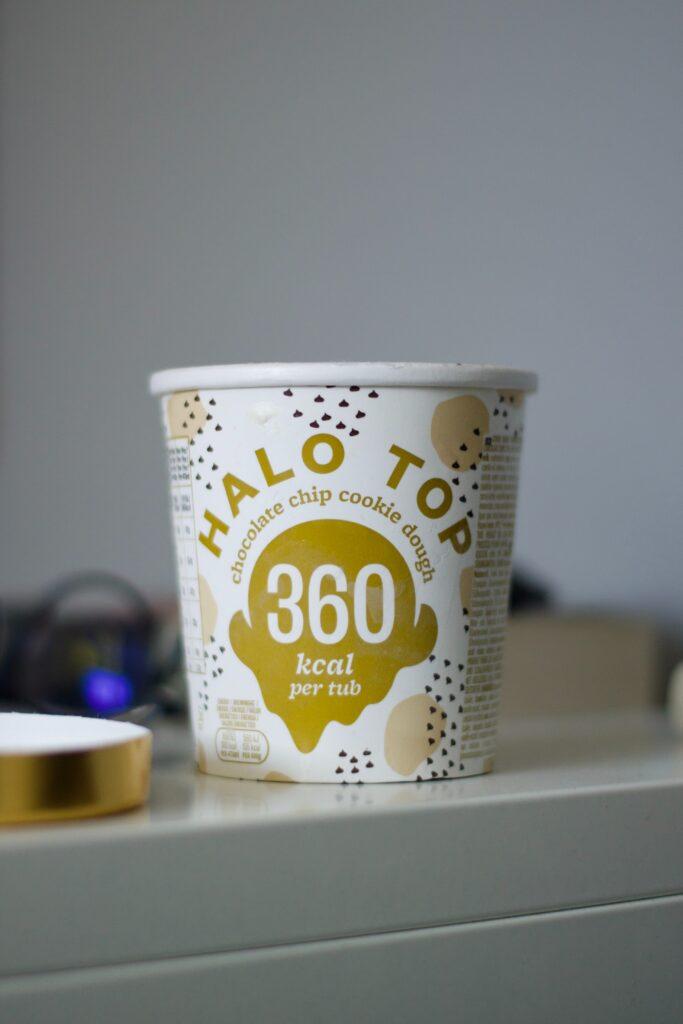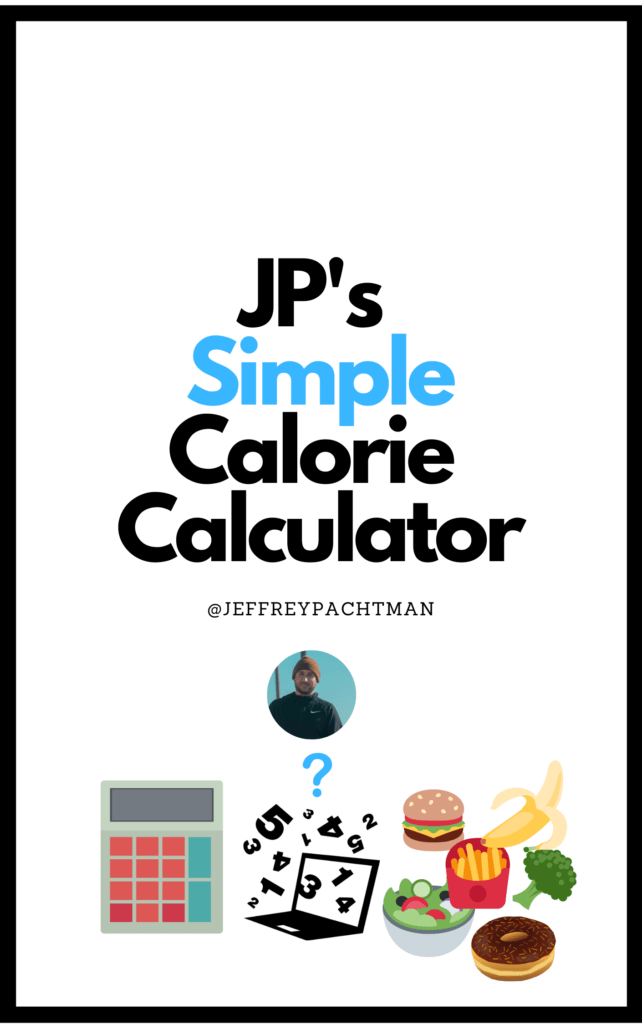Yo. My name’s Jeff and today I want to teach you how to stay in a calorie deficit so you can lose fat sustainably.
“Fat loss is simple. Just move more and eat less!”
– A young personal trainer in his 20s, who has had very few challenges in life other than arguments with his Mom about taking out the trash.
In theory, he’s right. Fat loss is simple on paper.
What’s not simple though, is staying in a calorie deficit long enough to see results.
With a subject as nuanced as nutrition, there is a LOT of misinformation, and the fitness industry is a big reason to blame for that.
By the time you’re done reading this article, you are going to know how to stay in a calorie deficit and lose fat without cutting out or restricting your favorite foods.
Before we get into my main tips on how to stay in a calorie deficit, first let’s explain exactly what a calorie deficit is.
Table of contents for how to stay in a calorie deficit
- What is a calorie deficit?
- How much of a calorie deficit should you aim for?
- How to know if you’re in a calorie deficit
- “What do I eat??”
- Foods that make fat loss easier
- Mindset hacks
- My top 3 strategies for staying consistent
What is a calorie deficit?
In order for me to explain the concept of a calorie deficit, let’s use an analogy:
@jeffpachtmanfitness Reply to @jeffpachtmanfitness #caloriedeficit #fatloss #howtoloseweight #weightlose #fatlosstransformation #fatlosstips #fatlosscoach #edutok #learnontiktok #fyp
♬ original sound – Jeffrey Pachtman
Imagine a bowl of water.
The smaller bowl represents your body. The bigger bowl represents your fat stores.
The water represents the number of calories you are consuming.
When the amount of water is enough to fill up the first bowl but not go into the second, this is called calorie maintenance.
If you were to eat this number of calories consistently, your weight would stay the same.
When the water fills up the first bowl and then spills into the second bow, this is called a calorie surplus.
This means you are eating more calories than your body requires to maintain its current weight and would cause weight gain.
This is not necessarily a bad thing, just not what we are trying to accomplish.
When the amount of water is less than the amount required to fill up the first bowl, you are in a calorie deficit.
This would cause weight loss.
How to stay in a calorie deficit
How much of a calorie deficit should you aim for?

Before we dive into this section, if you haven’t already, go ahead and grab yourself a copy of my free calorie calculator below.
This will help you find out exactly how many calories you should be eating for fat loss, and it will put you on my newsletter so I can send you free stuff and you can get ahold of me if you have any questions.
CLICK HERE TO GRAB MY FREE CALORIE CALCULATOR
When it comes to deciding how aggressively you should be dieting, I really like to remind people that losing as much weight as possible as quickly as possible is a recipe for disaster.
Trying to lose fat as quickly as possible is exactly why most people fail.
This is why I was very intentional with what I named this article. It’s not titled how to get into a calorie deficit, it’s titled how to STAY in a calorie deficit.
This is because anyone can get into a calorie deficit. Look at all the unsustainable weight loss advice out there—keto, fasting, paleo, whole 30…
They are all absolute garbage in my opinion because they don’t actually teach you how to still have foods you enjoy.
Regularly including foods that you love makes staying in a calorie deficit easier, and will make you much more consistent in the long run,
When it comes to how many calories you should be eating for sustainable fat loss, I really like using 2 different methods:
1. The goal bodyweight x 12 method.
Take your goal body weight (the weight that you would be your absolute leanest in pounds) and multiply by 12.
2. TDEE calculator.
You can go to tdeecalculator.com and find your maintenance calories, then subtract 250-500 from that number.
These will give you a good starting point, and you can gauge your progress using the scale, measurements, and how your clothes are fitting week-to-week.
No calorie calculator is going to be perfect, so make sure you just start with a number that seems doable.
The issue that most people run into is that they enter their info in 10 different calculators trying to find the “perfect” starting point.
There is no perfect starting point, so whether you use my calculator or someone else’s, the most important thing is that you just start.
How to stay in a calorie deficit
How to know if you’re in a calorie deficit
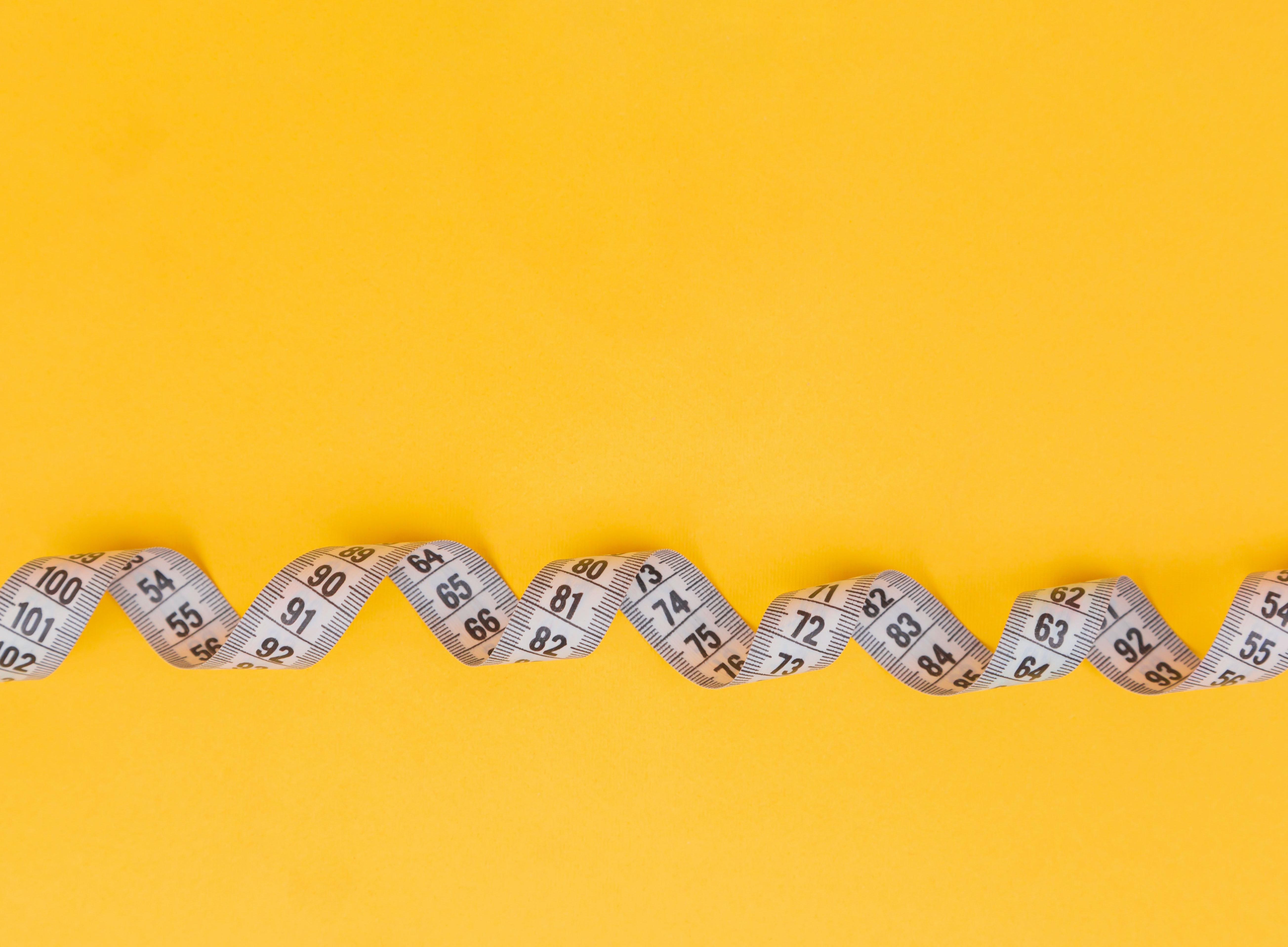
Great question.
We are going to use 3 methods to determine whether you’re in a calorie deficit.
By the end of this section, you will know exactly how to stay in a calorie deficit long enough to see results and use the correct metrics to determine your progress.
Pay attention because this is one of the most important parts.
1. The scale
Before you freak out and try to get me canceled for body-shaming, I want to teach you how to use the scale effectively.
There are a couple of things we need to do if we are going to use the scale. Here’s how to weigh in the right way:
- Weigh yourself every day or not at all.
- Weigh yourself right when you wake up, naked, after you’ve gone to the bathroom, and before you eat or drink anything.
- Write the number down and look at it as just data.
- Wait until you have a full week of data, and take an average by adding all the numbers up and dividing by 7.
- Compare your average weekly weigh-in week by week to make sure you are losing 0.5-1 lb per week.
NOTE: You may not lose weight every week, and that’s perfectly okay. I will talk about why you just need to keep going and not change anything.
Hint: It has to do with the WHOOSH effect.
2. Waist measurement
You are going to take your waist measurement in centimeters and record that every single week. This is the area right around your belly button.
Since this area doesn’t contain a lot of muscle, it’s actually a great indicator of whether you are losing body fat.
NOTE: This is not going to change every single week, but if you are consistent, it will change every 2-4 weeks.
3. Progress Photos
We are going to take progress photos every 4 weeks.
Make sure you use the same lighting, same poses, same angle. The fewer variables you have, the better.
Have someone else look at these photos with you, it takes a trained eye to see those small changes.
You can expect these changes to be noticeable around the 12-16 week mark.
How to stay in a calorie deficit
“What do I eat?”

One of the most common questions I get asked on Instagram is “Jeff, I am trying to eat in a calorie deficit, but I have no idea what to eat!”
The first question I will ask them is, “What are you eating right now?”
Chances are they already are eating similarly to how they should be in a calorie deficit, and we just need to make a few tweaks to make things easier.
People naturally eat what they enjoy, and my whole philosophy around nutrition is an 80/20 approach.
This means that you should eat 80% whole, nutrient-dense foods that make you feel good and provide you with the nutrients that your body needs.
The other 20% should come from foods that you actually enjoy.
This makes staying in a calorie deficit much easier and allows you to have some wiggle room.
Within this 80/20 approach, we need to talk about the importance of protein.
Protein will not only help you stay full, but it will also help to make sure that you are losing mostly fat and not muscle.
If you want to learn how to lose only fat and not muscle, by the way, check out this article here.
All of your meals should be centered around protein, and we will talk about exactly how many grams of protein you should be eating a little later.
Let’s say, for instance, Carrie loves having her morning bowl of granola with banana.
She can still have that granola, but we may want to increase the amount of protein in that meal by either adding some high protein milk, some protein powder, or maybe some egg whites on the side.
These are not the only options she can have, by the way, just some easy ones that I came up with on the spot.
Let’s say Carrie also likes having ice cream for dessert a couple of nights per week.
Does this mean that she should cut out her favorite dessert?
No. All she needs to do is fit them into her calories using a food tracking app like Myfitnesspal.
As long as she is eating 80% whole foods, 20% foods she enjoys, being mindful of protein, and eating within her calorie target, she will still be in a calorie deficit and lose fat.
How to stay in a calorie deficit
Foods That Make Fat Loss Easier
Rather than making an extensive list of foods that make staying in a calorie deficit easier, I am going to go over why certain foods may be more advantageous than others when fat loss is the goal.
1. Protein-rich foods
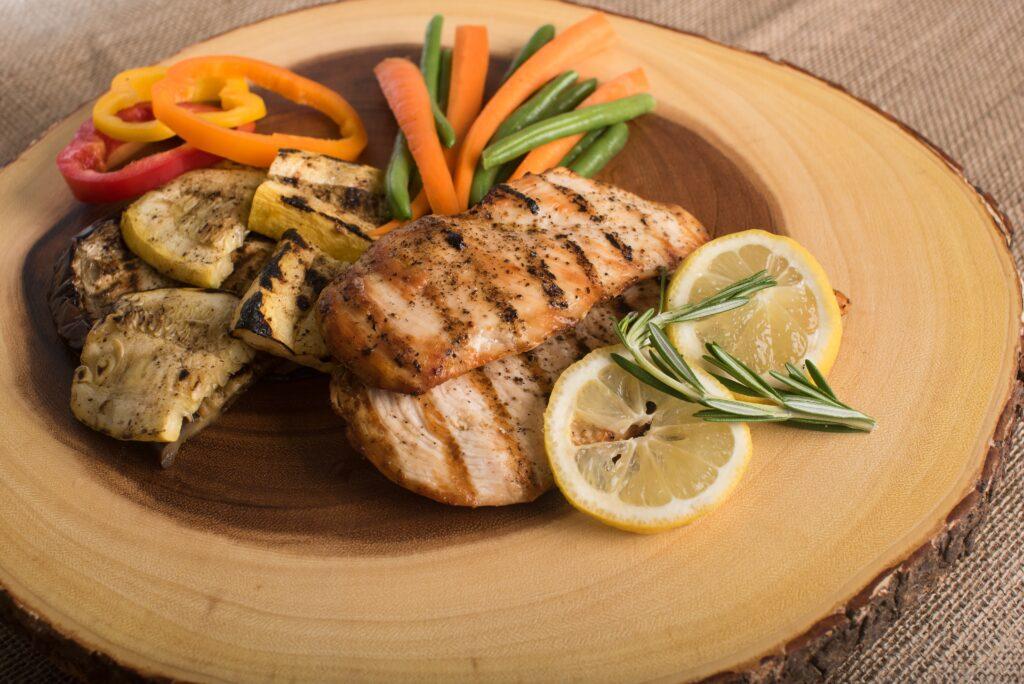
Protein is the main macronutrient that is going to keep you satiated and make fat loss a walk in the park (speaking of which, you should be walking more…more on this later ;).
Bodybuilders have figured this out a LONG time ago, so we can take a page out of their playbook.
When it comes to getting lean, sometimes calories may have to get lower, so staying full becomes crucial.
The more protein you have in your diet, the fewer cravings and hunger you are going to have to deal with. (1)
Research suggests that you should aim for around 1.2-1.6g/kg of protein per day (2), but to keep this super simple, let’s break it down like this:
0.8-1g of protein per lb. of goal body weight.
You already found your goal bodyweight earlier, so just use that number and multiply by 0.8 to find your low end of the range. Then multiply by 1 to find your higher end of the range.
EX: If Carrie wants to weigh 150 pounds, she would multiply her goal bodyweight by 0.8, and then by 1.
Her protein would range from 120-150g per day. As long as she hits that number, she is good to go.
What to do if this seems like a lot:
If you are only eating 50g of protein per day, try adding another 30 grams per day.
Once you are comfortable with that, add another 30 grams.
Keep adding in more progressively until you get to your target. This will make hitting your protein target less daunting and more sustainable for you.
I recommend a minimum of 30g of protein per meal, and even include a few protein shakes/supplements if you are still struggling to hit your target.
If you want a list of some high-protein snacks, check this out.
PS: If you want some of the tastiest and highest quality protein powder on the market, check out Legion. You can also use my code: Jeff to get 20% off your entire order.
2. Fiber-rich foods
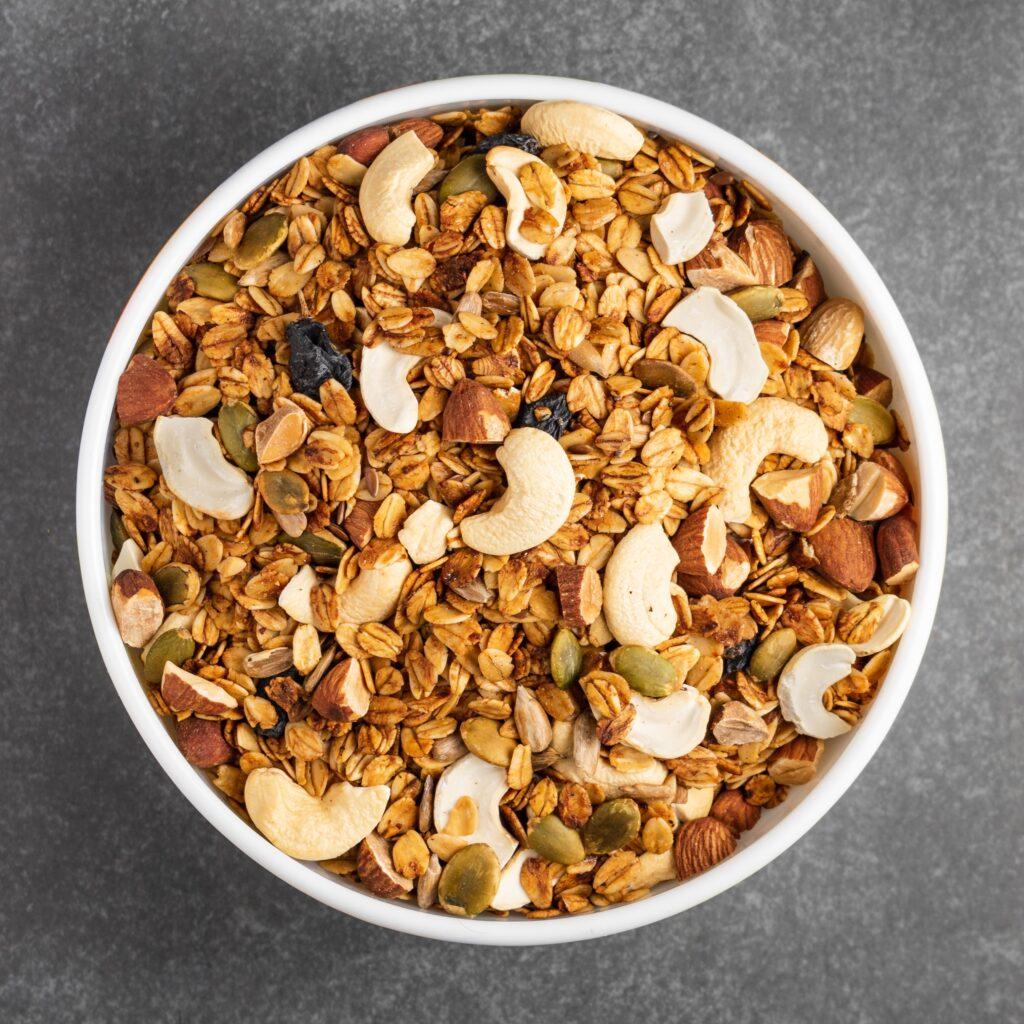
When discussing how to stay in a calorie deficit, fiber has to be one of the most overlooked factors.
Not only does eating adequate fiber help with digestion and keep you regular, but it has also been shown to help with post-meal satiety and may even help regulate weight loss in both obese and healthy weight individuals. (3)
By the way, these recommendations also include fiber supplements like Metamucil and psyllium husk, so just get it in however you can.
If you want to test this out, try this:
Track your calories for a period of time, and then look at your average fiber intake. The average American eats about 15g of fiber per day.
Most recommendations for adults are 14g per every 1,000 calories.
This means that you should be aiming for around 20-40g per day.
So how do you get that much fiber?
Here’s a list of high fiber foods (this is not an exhaustive list, just foods that I enjoy):
- Pears
- Mangoes
- Whole wheat bread
- Popcorn
- Bananas
- Avocados
- Lentils
- Black beans
- Chickpeas
- Hummus
- Oats
- Carrots
- Spinach
- Low carb tortillas
- Joseph’s Lavash wraps
- Chia seeds
- Flax seeds
- Pumpkin seeds
- Berries
- Zucchini
- Squash
- Potatoes and sweet potatoes
- Bell peppers
- Green beans
3. Franken-foods

Alright, so hear me out.
Foods like jello, shirataki noodles, cauliflower rice, zucchini noodles have their place, but for the most part…these foods suck.
Using tomato as a bun, using “keto bread”, or even noodles made from egg whites may not be your thing.
I get it.
As a former chef, and food enthusiast myself, I don’t particularly enjoy these low-calorie “franken-foods”.
However, I do make exceptions when calories get low, and eating these kinds of foods can help increase the volume and satiety of your meals.
If you want a list of foods that I give to my 1-1 coaching clients to help them increase the volume of their meals, check out this article here.
How to stay in a calorie deficit
Mindset Hacks To Help You Stay In A Calorie Deficit

Even if I tell you all the tips and tricks on how to stay in a calorie deficit, most people will not implement them.
Why?
Because knowing is not half the battle.
1. Knowing is not half the battle
Let me explain.
You may know that putting 20% of your paycheck each month into your 401k is a good idea, but most people don’t do it.
It’s not that they are dumb, or that they don’t want to set themselves up for retirement.
We simply have monkey minds.
Our minds are constantly blocking us from looking at what we should be doing and keeping us locked into what we WANT to be doing.
Our mind craves dopamine.
This is a neurotransmitter in our brain that tells us when we are feeling pleasure.
The problem with dopamine is that it gets us addicted to short-term pleasure.
Think high-calorie, fatty, salty foods.
If you ever want to see a good example of this, just go to a casino and look at the zombie-like droves of individuals cranking at the shiny handles of the slot machines.
This is an example of dopamine addiction at its finest.
So how do we combat this constant monkey mind that tells us to reach for the shiny things that lead us only to long-term despair?
2. Play The Tape Forward
This is actually a strategy that has been used in addiction recovery for quite some time.
The main reason most people fail to stay in a deficit is the “golden carrot syndrome”.
They simply lack the ability to stick with the plan because doing so means they must make some sacrifices in the short term.
Playing the tape forward allows us to look at the long-term repercussions of making “comfortable” short-term decisions.
For example, let’s say you are trying to eat 2,000 calories per day for fat loss.
You pre-log your entire day of eating in Myfitnesspal to hold yourself accountable.
After dinner, you get a text from a friend inviting you out for drinks.
You have already eaten 1800 calories, and know that going out will most likely lead to you overconsuming calories that day.
If you play the tape forward, you will make the decision that benefits you long-term.
This may mean going out to socialize and having one drink.
It may mean staying in because you know that you can’t just have one drink.
It also may mean you checking yourself into rehab. (Kidding)
Either way, playing the tape forward is a great tool that you can use to set your future self up for success.
3. Don’t quit 5 minutes before the miracle happens
After working with dozens of fat loss coaching clients, one of the things I see tripping people up the most is setting unrealistic expectations.
In other words, how quickly this whole fat loss thing is going to happen is a lot slower than most people think.
During the first week of a calorie deficit, it’s common for someone to drop 2-4 pounds. Maybe even more.
It’s not only fat though.
It’s a combination of fat and water weight.
Then week 2 comes around and things start to get a bit slower.
Week 3 and 4 pass and now things have almost come to a complete screeching halt.
What gives?
Once you have gotten comfortable with your deficit, you start letting the reins loose a bit.
You start swigging orange juice out of the fridge.
Stealing nibbles of Nabisco snacks when no one is looking.
Getting really sloppy with your tracking.
Not only that but there are really subtle changes happening in your body that the scale is not showing.
- You have dropped inches around your waist.
- Clothes are fitting better.
- Lifts are going up.
- You are drinking more water.
- You’ve been getting in more steps.
- You are getting more confident.
- Your skin is clearing up.
You see, even though weight loss isn’t occurring at the rate you want it to currently, there are dozens of other markers of progress that you are failing to recognize.
This is where most people give up.
They make up excuses for their lack of progress like hormones or metabolism, and then continue eating like an asshole.
OR…
They do what clients like my good friend Talie do, and they keep going no matter what.

The Whoosh Effect

You are my kind of person. You don’t give up.
When you keep going, something called the WHOOSH happens.
The whoosh effect is when your weight has been stalled for weeks on end, and then all of the sudden you see a big drop in your weight.
I have seen this happen with clients who have been very consistent, and they just weren’t seeing results, and then all of the sudden…WHOOSH.
4 pounds down overnight.
These are usually the same clients that earlier in their lives would have quit, but because they had shifted their mindset to long-term (I wouldn’t take them on as a client if they didn’t), they stayed patient long enough to hit that WHOOSH.
I say that to say this— No matter what, just don’t quit. The only way to mess this up is to give up completely. If you keep going, there is no way you can lose.
Check out this video about how to transform your mindset for fat loss”
How to stay in a calorie deficit
My Top 3 Strategies For Staying Consistent
When it comes to staying in a calorie deficit long enough to see results, the main driver of your progress and how quickly you achieve that progress is consistency.
These are my top 3 strategies for staying consistent:
1. Progressive overload
You may have heard this principle talked about when it comes to lifting weights, but you can apply progressive overload to anything you want to do in life.
Here’s an example of how you could apply it for fat loss:
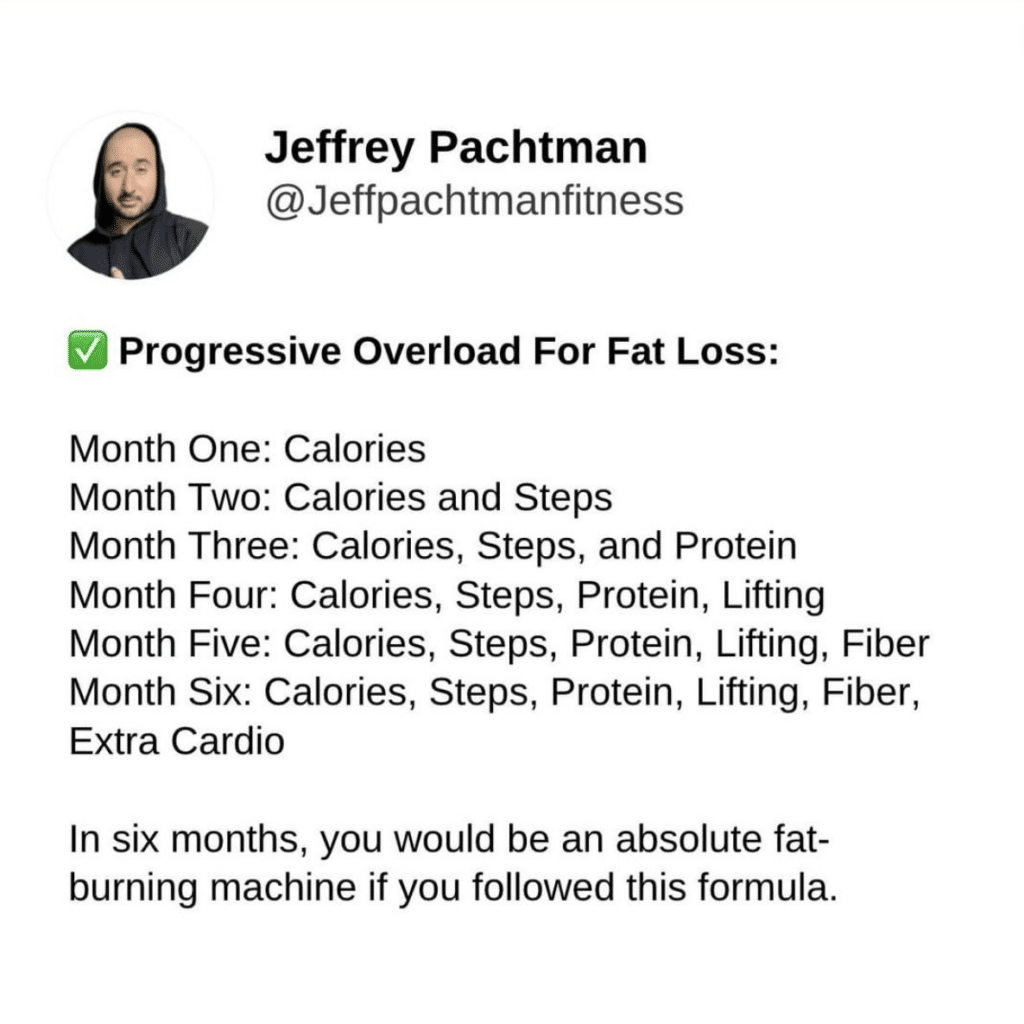
What makes this method effective is adding in one new habit to focus on each month until it becomes a routine.
The key is not OVERLOADING yourself right off the bat.
You wouldn’t walk into the gym for the first time and put 225 on the bench press…
So why are you doing this when it comes to extreme dieting?
It’s not sustainable and it’s the reason why you throw in the calorie deficit towel.
So how do you make habits stick?
You do them every day.
Day after day.
Make them non-negotiable.
When you first learned how to make your bed as a kid, it probably seemed like a chore. But after doing it for 20+ years, now you feel off-kilter if your bed isn’t made properly.
It’s become a part of your routine.
It is no longer a decision you have to make.
You can do the same thing by eating more fruit and veggies.
Eating more protein.
Walking more.
Getting to bed earlier.
Lifting 3x per week.
But if you try to do them all at once, you are going to fail.
This is why using progressive overload works so well.
You just start with ONE habit.
Do that habit very well consistently for a while.
Once it becomes second nature, stack another one on top.
Once that becomes routine, stack another one.
In 6 months, you will become a fat-burning machine.
Skip the fad diets.
Nix the juice cleanse.
Those things will get you fast results, but long-term will leave you worse off than before you started.
Applying progressive overload is a time commitment, but it will be sustainable.
With this method, you will be able to stay in a calorie deficit long enough to see results.
2. Plan Ahead
I know this one seems obvious, but creating a schedule for yourself can really help when you are struggling with consistency.
Creating those non-negotiable eating times, walking times, and training times for yourself really does make it so much easier to stick to.
Try planning out your week in your google calendar and make sure to block out periods of time for things like walking, lifting, grocery shopping, meal prepping, etc…
Something that I and my coaching clients do regularly is to plan out our full day of eating in Myfitnesspal the night before.
This will help us stick to our goals and make sure we are hitting our calories, protein, and fiber with the foods that we already have available in the house.
3. Be 80% Consistent
Setting up some sort of consistency tracker will help in holding yourself accountable.
If you are a visual learner, this could look like setting up a consistency calendar.
In essence, this is just a calendar that you hang on your wall to keep track of your consistency.
Some common markers I use with clients are calories, protein, and steps.
For every day that they hit all three of these targets, I have clients mark their calendar with a big X. If they missed it, they would mark it with an O.
At the end of the month, they can look back at all of their X’s and O’s and do some math to figure out their consistency percentages.
The main thing the consistency calendar teaches us is to not be perfect, but be good enough to do damage.
If there are 30 days in the month, and you have 4 O’s on your calendar, that’s 86% consistent. You will be seeing excellent results with this kind of progress.
Another important thing to note is to plan out your O days.
In other words, if you are going on a road trip for 4 days next week, and you know that you don’t want to worry about nutrition or steps, take those 4 days and make those your O days.
However, if you do this, make sure to be on point the rest of the month. You had your fun 😉
If you are someone, however, who likes to let loose on Saturdays and enjoy some good restaurants with your family, take those four Saturdays each month to be your O days.
This will still allow you to have some flexibility on the weekends, but you will still make progress as long as the rest of the week is dialed in.
How to stay in a calorie deficit
What’s Next?
Well if after reading this blog post, you still feel like you could benefit from some extra guidance, you can apply for my 1-1 online coaching program Fat Loss Foundation.
If you want to find out more about losing weight and how to go about it in a smart, sustainable way, check out my podcast.
If you are more of a visual learner, you can also find me on Youtube.
Here are a few more articles I think you’ll enjoy:
How to bounce back strong after a cheat day
How to diet break for fat loss
How to find time to workout on a busy schedule
Thank you so much for reading this far, I really do appreciate you for taking the time out of your day to read my articles.
Hope we chat soon.

